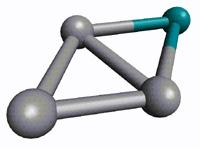cyclic SiC3, prolate isomer, 1A1
 | |
|---|---|
| Species tag | 064501 |
| Version | 2* |
| Date of Entry | Jan. 2019 |
| Contributor | H. S. P. Müller |
|
The molecule may be the lowest energy isomer of
SiC3. With respect to the first entry
from Jan. 2000, the majority of the experimental
transition frequencies were taken from | |
| Lines Listed | 1973 |
| Frequency / GHz | < 1000 |
| Max. J | 92 |
| log STR0 | -6.0 |
| log STR1 | -4.5 |
| Isotope Corr. | -0.1401 |
| Egy / (cm–1) | 0.0 |
| µa / D | 4.04 |
| µb / D | |
| µc / D | |
| A / MHz | 37951.8 |
| B / MHz | 6284.94 |
| C / MHz | 5388.84 |
| Q(300.0) | 12243.4263 |
| Q(225.0) | 7949.9944 |
| Q(150.0) | 4326.5715 |
| Q(75.00) | 1529.9588 |
| Q(37.50) | 541.4398 |
| Q(18.75) | 191.8509 |
| Q(9.375) | 68.1408 |
| Q(5.000) | 26.8176 |
| Q(2.725) | 11.4727 |
| detected in ISM/CSM | yes |